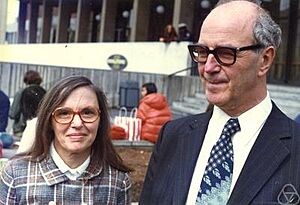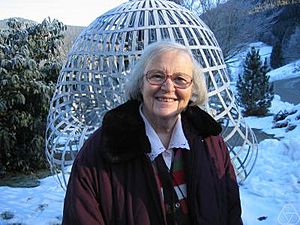Yvonne Choquet-Bruhat facts for kids
Quick facts for kids
Yvonne Choquet-Bruhat
|
|
|---|---|

Choquet-Bruhat in 1974
|
|
| Born |
Yvonne Suzanne Marie-Louise Bruhat
29 December 1923 |
| Died | 11 February 2025 (aged 101) Mérignac, France
|
| Alma mater |
|
| Known for |
|
| Spouse(s) |
|
| Children | 3, including Daniel |
| Awards |
|
| Scientific career | |
| Fields | |
| Institutions | Pierre and Marie Curie University |
| Thesis | Théorème d'existence pour certains systèmes d'équations aux dérivées partielles non linéaires (1951) |
| Doctoral advisor | André Lichnerowicz |
Yvonne Choquet-Bruhat was a brilliant French mathematician and physicist. She was born on December 29, 1923, and passed away on February 11, 2025, at the age of 101.
Yvonne made very important discoveries about general relativity, which is Albert Einstein's theory about gravity and how the universe works. She showed that Einstein's equations, which describe gravity, could be solved in a way that made sense and had unique answers. This was a huge step forward in understanding the universe.
In 2015, a science journal called Classical and Quantum Gravity recognized her work. They listed her breakthrough paper as one of the top thirteen most important results in general relativity over 100 years. Yvonne Choquet-Bruhat was also the first woman ever to be chosen as a full member of the French Academy of Sciences. She also received the Grand Officier award, which is a very high honor in France.
Early Life and Education
Yvonne Bruhat was born in Lille, France. Her mother, Berthe Hubert, was a philosophy professor. Her father, Georges Bruhat, was a physicist who sadly died in 1945. Yvonne's brother, François Bruhat, also became a mathematician.
Yvonne went to high school in Paris. In 1941, she earned her Baccalauréat, which is a French high school diploma. She also won a silver medal in physics in a big national competition called the Concours général.
From 1943 to 1946, she studied at a famous school in Paris, the École normale supérieure de jeunes filles. After graduating, she worked there as a teaching assistant. She also started her research under the guidance of André Lichnerowicz.
A Career in Science
From 1949 to 1951, Yvonne worked as a research assistant at the French National Centre for Scientific Research (CNRS). During this time, she earned her doctorate degree.
In 1951, she became a researcher at the Institute for Advanced Study in Princeton, New Jersey, USA. Her mentor, Jean Leray, suggested she study how Einstein field equations behave. She even met Albert Einstein himself and talked with him a few times about her work.
In 1952, Yvonne and her husband got job offers in Marseille, France. So, she left the institute early. That same year, she published her most famous work. She proved that there are unique solutions to Einstein's equations in a specific situation. This discovery was very important because it helped scientists understand how gravity works over time.
In 1958, Yvonne received the CNRS Silver Medal for her excellent research. From 1958 to 1959, she taught at the University of Reims. In 1960, she became a professor at the Université Pierre-et-Marie-Curie (UPMC) in Paris. She remained a professor there until she retired in 1992.

At the Université Pierre et Marie Curie, she continued to make big contributions to mathematical physics. This included her work on general relativity and other complex theories like supergravity. In 1981, she worked with Demetrios Christodoulou to show how certain important equations in physics have solutions that last over time.
In 1978, Yvonne Choquet-Bruhat was elected as a correspondent to the French Academy of Sciences. On May 14, 1979, she made history by becoming the first woman to be elected a full member of the Academy. From 1980 to 1983, she was the President of the International Committee on General Relativity and Gravitation. In 1985, she was also elected to the American Academy of Arts and Sciences. In 1986, she was chosen to give the special Noether Lecture by the Association for Women in Mathematics.
Personal Life
In 1947, Yvonne married another mathematician, Léonce Fourès. Their daughter, Michelle, became an ecologist. Yvonne's early research papers were published under the name Yvonne Fourès-Bruhat.
In 1960, Yvonne and Léonce divorced. She later married another mathematician, Gustave Choquet, and changed her last name to Choquet-Bruhat. They had two children together. Her son, Daniel Choquet, is a neuroscientist, and her daughter, Geneviève, is a medical doctor.
Yvonne Choquet-Bruhat lived a long and impactful life, passing away in Mérignac, France, in 2025.
Awards and Honors
Yvonne Choquet-Bruhat received many awards for her important work:
- Médaille d'Argent du Centre National de la Recherche Scientifique (Silver Medal from the French National Centre for Scientific Research), 1958
- Prix Henri de Parville of the Académie des Sciences, 1963
- Member of the International Committee on General Relativity and Gravitation (President from 1980–1983)
- Elected to the French Academy of Sciences, 1979
- Elected to the American Academy of Arts and Sciences, 1985
- Noether Lecturer by the Association for Women in Mathematics, 1986
- Commandeur de la Légion d'honneur, 1997
- Dannie Heineman Prize for Mathematical Physics, 2003
- Elevated to the 'Grand Officier' and 'Grand Croix' dignities in the Légion d'Honneur in 2008, which are very high honors.
See also
 In Spanish: Yvonne Choquet-Bruhat para niños
In Spanish: Yvonne Choquet-Bruhat para niños


